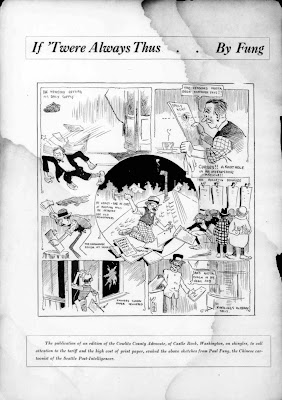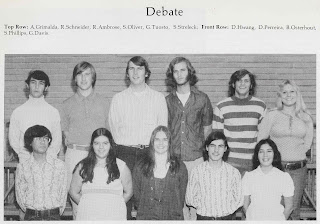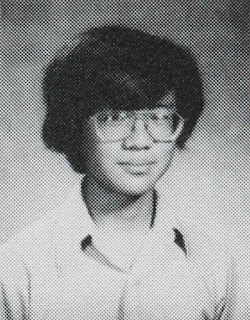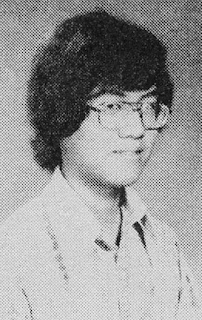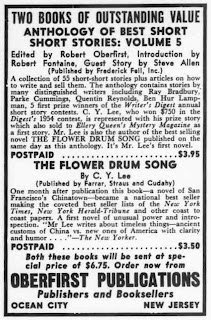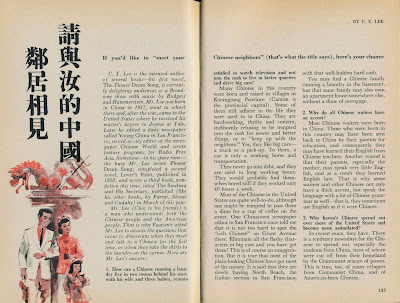Page 440: Chinese Plays
... Thy Son Is Right by Lee Chin-Yang, a four-act melodrama dealing with a Sino-Burmese border incident, was the major spring production at Yale. The play, Mr. Lee’s third, is the climax of two years of uprooting at the hands of the Japanese which tore the playwright from his position as overseer of a section of the Burma Road and eventually brought him to the United States.
Pages 532–538: The Land of Nobody
Pages 656–660: Movies Come to China
Page 424, column 3
... two new plays at the Yale University Theatre, Gideon by Randolph Goodman and Laurel in the Moon, a Chinese comedy by Chin-Yang Lee ...
Page 46: Prize Winners
$3,000 Writer’s Digest Short Fiction Contest
1st Prize of $750 Goes to C. Y. Lee
226 Third Street
Pacific Grove, California
(story published in Ellery Queen’s Mystery Magazine)
Writer’s Digest, August 1955
Page 36: 1955 Short Short Story Contest Winners
Ellery Queen’s Mystery Magazine, February 1957
Pages 104–106: The Forbidden Dollar
“The Forbidden Dollar” is the author’s first published short-short story. It won First Prize of $750 in the “Writer’s Digest” contest of 1954 and was awarded third prize in the forthcoming Volume 5: Best Original Short-Shorts, edited by Robert Oberfirst, to be published by Frederick Fell in March 1957.
The New Yorker, March 30, 1957
Writer’s Digest, September 1957
The New Yorker, July 26, 1958
The New Yorker, August 30, 1958
The New Yorker, September 12, 1958
Page 15: ... Rodgers and Hammerstein’s The Flower Drum Song, their adaptation of C. Y. Lee’s novel on San Francisco’s Chinatown ...
The New Yorker, December 6, 1958
The New Yorker, December 20, 1958
Stanford University Dramatists’ Alliance, 1958
Page 2: Came the Year of the Rooster
In the competitions of Dramatists’ Alliance for 1953, a young writer named Chin Yang Lee submitted plays for all three categories: Half Hour at Paradise (Alden), a comic sketch of the Chinese student practising his American slang; The Laurel in the Moon (Etherege), a delicate and elusive play of happy love on the China-Burma border; and Madam Gold Flower (Stevens), an austere story of a bold, a enchanting woman patriot during the Boxer Rebellion. The last two won honors and went to the judges, but the elusive atmosphere, the hinted plot, the sly humor, all as true (and as strange) as a painting on Chinese silk, left the judges uncertain was to how these shrewd and brittle pieces could be staged in a way to show the value and charm; they remained honors plays.
Pageant, May 1959
Pages 136–141: Meet Your Chinese Neighbors
Rogue, September 1959
Pages 40–41, 74, 86: The Casanova of Kearny Street
Gent, February 1960
Pages 52–55, 70: Chicken, Wanna Neck
Coronet, March 1961
Aware, December 1961
Pages 28–39, 70: The Cheongsam
Cavalcade, December 1961
Pages 17–18, 60–62, 70: Sideline Girl
Writer’s Yearbook, 1961
Pages 33–34: The Flower Drum Song
Rogue, March 1963
Pages 50–52, 60, 62, 79–81: What Makes a Smash Hit? ... or: how “Flower Drum Song” danced its way from the pages of The New Yorker to Broadway and Hollywood, bringing its writer fame and fortune.
Los Angeles Times, West magazine, February 13, 1972
Pages 12–13: The Year of the Rat Is Here
Further Reading
Gent (Playboy magazine imitator)
Rogue (Playboy magazine imitator)
Related Posts
